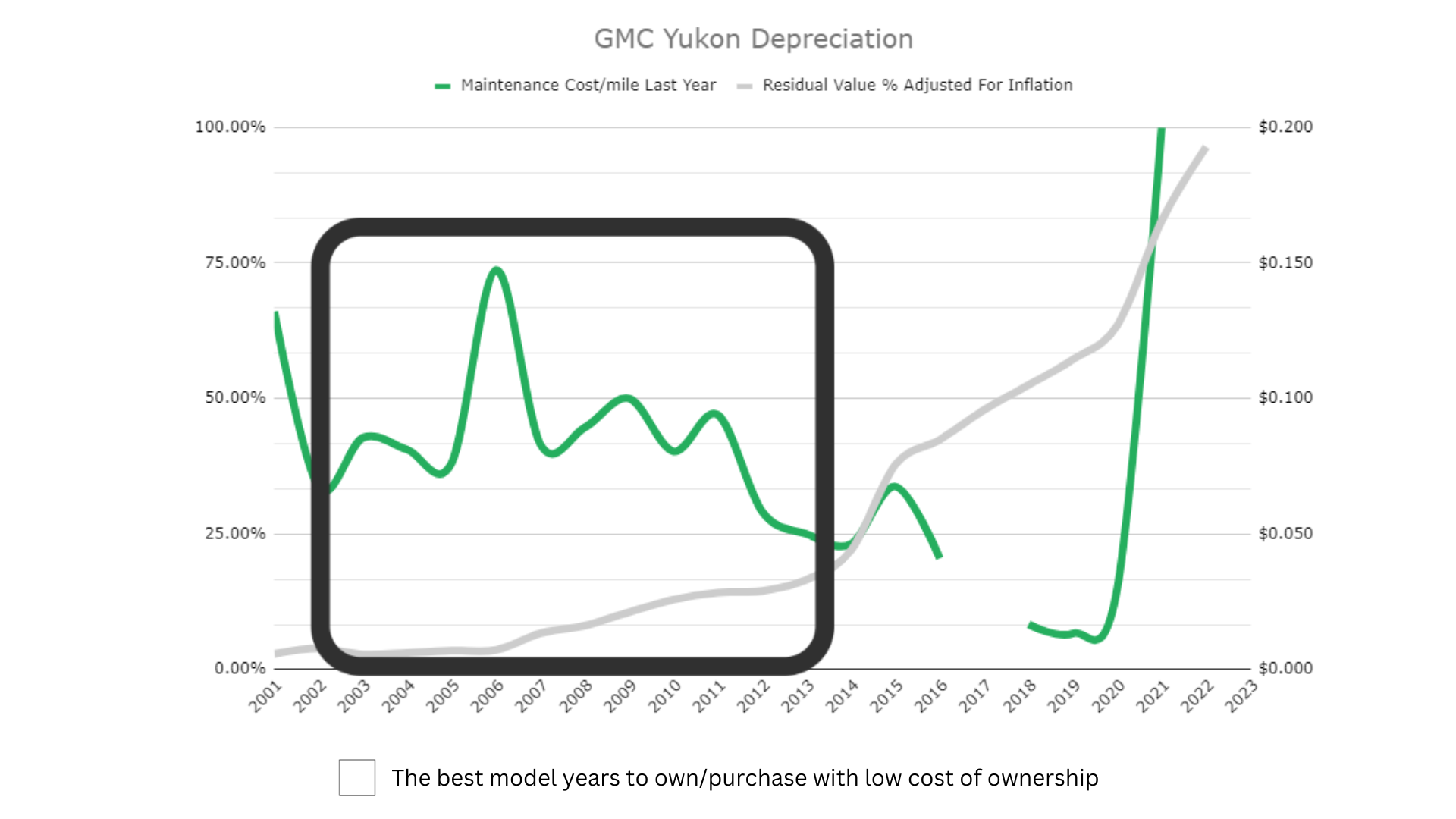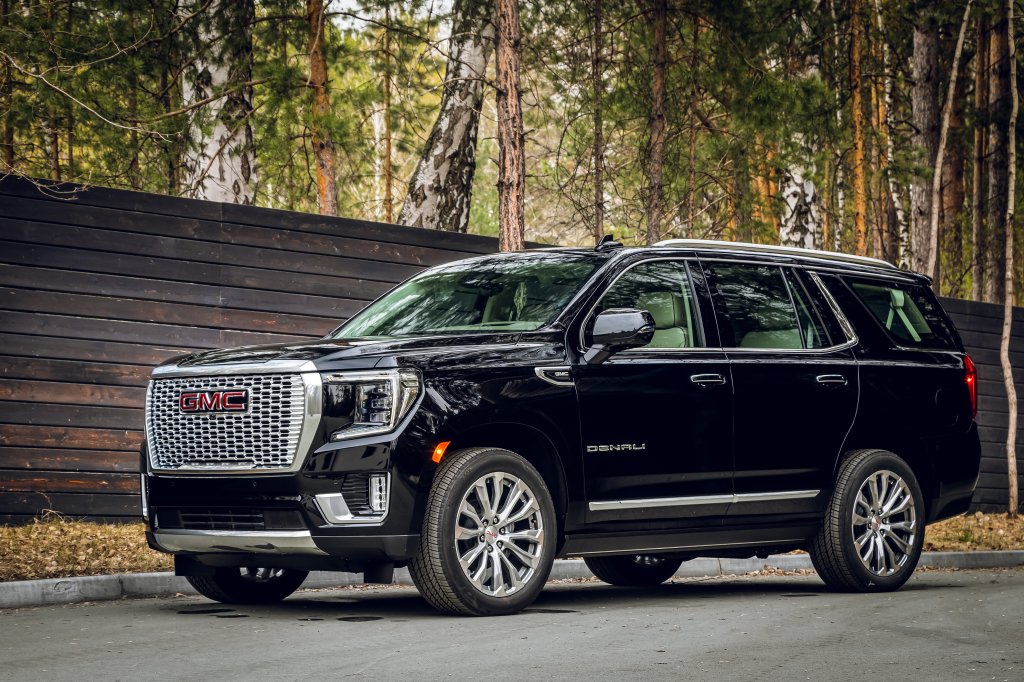Find the depreciation rate of your GMC Yukon in the graph below.

All cars depreciate, or lose value, from the moment of purchase, and that’s true for the GMC Yukon. The highest depreciation rate occurs in the first year after purchase. After the first year, the Yukon will continue to depreciate at a slower rate until it reaches the six-year mark. Vehicles depreciate at different rates depending on their make and model. Before purchasing a specific vehicle, learn about its depreciation rate to understand its long-term value and the total cost of ownership.
Keep in mind that just because the vehicle costs the least to own in the sweet spot we have outlined here, you still may not want to own the vehicle during these depreciation sweet spot years. Although vehicles depreciate less as they get older, they have more repairs. Duh right? However, keep in mind that repairs don’t just cost you money, they cost you time. Reliability is the difference between being able to make it to your destination on time or missing an opportunity because the car broke down.
Check out our article on the best and worst years of the GMC Yukon to see our reliability ratings for all years of the Yukon between 2001-2022. We also cover MPG, safety ratings, and a number of other factors. We pulled data from Yukons registered in our app and surveyed owners to get you data-backed answers on just how good or bad each year of the Yukon is.
If you want to know the depreciation and maintenance costs for your particular vehicle, use our free “Total Cost of Ownership” tool available in the FIXD App – Android or IOS.
If you like our online tools and articles consider purchasing our FIXD sensor for $19.99 (this is 67% OFF). It’s our flagship product. With it, you scan your car for common engine problems.
If our sensor detects any problems with the engine, our app will clearly explain:
- What could have caused it and
- How much the possible repairs may cost.
If you’d like, we’ll even show you trusted repair shops in your area where you can get your ride fixed through RepairPal. The total cost of ownership feature within the app totals your maintenance costs, repairs, and depreciation (Sensor + App). This is free on the app.
GMC Yukon Depreciation
| Model Years | Mileage | Amount Depreciated | Residual Value Percentage | Resale Value |
| 2001 | 264,000 | $43,242.66 | 2.9% | $1,309 |
| 2002 | 252,000 | $40,642.96 | 3.9% | $1,654 |
| 2003 | 240,000 | $43,068.97 | 2.8% | $1,248 |
| 2004 | 228,000 | $43,944.04 | 3.1% | $1,415 |
| 2005 | 216,000 | $44,405.66 | 3.5% | $1,610 |
| 2006 | 204,000 | $45,279.58 | 3.6% | $1,712 |
| 2007 | 192,000 | $41,243.52 | 6.7% | $2,952 |
| 2008 | 180,000 | $42,450.08 | 8.1% | $3,718 |
| 2009 | 168,000 | $44,267.95 | 10.6% | $5,241 |
| 2010 | 156,000 | $42,749.86 | 12.9% | $6,311 |
| 2011 | 144,000 | $41,501.33 | 14.2% | $6,865 |
| 2012 | 132,000 | $42,321.50 | 14.5% | $7,171 |
| 2013 | 120,000 | $42,546.08 | 16.6% | $8,461 |
| 2014 | 108,000 | $42,188.57 | 22.0% | $11,933 |
| 2015 | 96,000 | $35,935.10 | 37.8% | $21,846 |
| 2016 | 84,000 | $33,627.75 | 42.4% | $24,761 |
| 2017 | 72,000 | $30,646.31 | 47.9% | $28,148 |
| 2018 | 60,000 | $28,357.43 | 52.5% | $31,390 |
| 2019 | 48,000 | $25,690.10 | 57.2% | $34,344 |
| 2020 | 36,000 | $22,875.04 | 63.5% | $39,737 |
| 2021 | 24,000 | $10,194.54 | 82.8% | $49,069 |
| 2022 | 12,000 | $1,982.46 | 96.4% | $53,508 |
| 2023 | N/A | N/A | N/A | N/A |
| 2024 | N/A | N/A | N/A | N/A |
This chart shows the approximate depreciation for a GMC Yukon. It’s based on Kelley Blue Book data since 2001, assuming a vehicle in standard trim, a generic color such as black or white, and a mileage of 12,000 per year.
Keep in mind that the auto market was heavily affected in 2020 and beyond. Automakers selling new cars during the COVID pandemic raised prices which caused a spike in demand in the used car market as people tried to save money. Many automakers, however, did not drop prices after the pandemic, they kept them so they could make a larger profit.
This is why the most recent years of many vehicles have seemingly experienced less depreciation. Some, such as 2002, may have even appreciated due to the heightened levels of inflation created.
Factors That Impact the GMC Yukon Depreciation Rate

GMC, part of General Motors, is well-known for its line of SUVs and pickup trucks. The company produces vehicles that are mechanically similar to Chevrolets, since GM owns both companies. The main difference is that GMC brands its vehicles as more high-end, offering premium features and luxury trims. While GMC makes popular vehicles, it often gets low scores for quality and reliability. Besides the automaker’s reputation, here are some other factors that can affect the depreciation of your GMC Yukon.
Age
The model year of a vehicle can affect its resale value. A vehicle’s model year refers to a specific generation, which determines its features and pricing. As a vehicle ages, it usually depreciates in value, since older vehicles often require more maintenance and repairs.
Manufacturers such as GMC release new versions of their vehicles each year. With the release of a new model year, the outgoing model year usually depreciates quickly. Each model year has different features, and in some years, a vehicle gets a complete redesign. For this reason, some model years hold their value better than others.
Body Type
Body type, also known as body style, designates the size and shape of a vehicle. Some common body types include sedans, coupes, hatchbacks, convertibles, sports cars, sport utility vehicles, station wagons, minivans, and pickup trucks. Different body styles depreciate at varying rates, usually based on market demand. In North America, there’s a strong demand for SUVs and pickup trucks, so those vehicles tend to depreciate at a slower rate. Luxury cars, in comparison, often experience the fastest depreciation.
The GMC Yukon is a full-size SUV with three rows of seats for seven to eight passengers. Typically, full-size SUVs have a slower depreciation rate than compact cars such as sedans and hatchbacks. If the market changes and demand grows for other vehicle body styles, then the Yukon might start to depreciate more quickly.
Mileage
Like age, high mileage can cause a vehicle to lose value. As a vehicle accrues more miles, it typically shows more wear and tear. It may even require advanced maintenance or extensive repairs.
The average driver travels slightly more than 1,000 miles each month, according to the Federal Highway Administration. That’s why we base our models on 12,000 miles of driving per year. If you drive more than the average, your vehicle may have a faster depreciation rate. If you drive fewer miles each year, your vehicle might retain its value longer.
Overall Condition
You can determine a vehicle’s overall condition based on its mechanics and interior and exterior appearance. A vehicle in good condition will typically be worth more than the same vehicle in poor condition. Keep your Yukon in good condition by following GMC’s recommended maintenance schedule, which includes services such as oil changes and tire rotations. Additionally, avoid major damage and keep the vehicle looking good.
While routine maintenance is essential, at some point it may not make sense to keep fixing a car. If it requires major repairs or maintenance, consider the value of the vehicle before you decide whether to pay to fix it. If repairs cost more than the car’s worth, it might be a better idea to sell the vehicle and buy a new one.
Color
Depending on what’s important to you, a car’s color might be the top consideration in your car search, or you might not think about it at all. But you should consider the color if you want to get the most value for your Yukon down the road. According to a study by iSeeCars, some colors depreciate more slowly than others. Specifically, colors such as yellow, beige, green, and red have slower depreciation rates. Common vehicle colors, such as black, brown, and gold, depreciate the quickest, most likely because there are more vehicles available in those colors.
Other Costs of GMC Yukon Ownership
The depreciation rate of a GMC Yukon can affect its long-term value, but it’s not the only factor to consider in the total cost of ownership. Here are some other costs to consider before purchasing a Yukon.
Insurance
Car insurance companies base your premium on the vehicle you drive, making some cars more expensive to insure than others. Usually, cars with more safety features and high-reliability scores have lower insurance costs than other vehicles.
On average, it’s slightly more expensive than average to insure a GMC Yukon. It costs $161 per month to insure a Yukon, according to The Zebra. Comparatively, the average cost of car insurance is $147 per month. Over one year, that’s a difference of about $173. However, other factors, including your driving history and where you live, can also impact your auto insurance premiums.
Maintenance
Regular maintenance can keep your Yukon running smoothly, which can improve its resale value. The average annual maintenance cost for a GMC Yukon is $1,009. That’s significantly higher than the overall average maintenance cost of vehicles, which is $694 per year. You can compare the maintenance costs of a GMC Yukon by model year using our graph.
Some model years of the Yukon might be more expensive to maintain than others. In particular, these model years have a history of recalls and extensive repairs, including issues related to the engine and transmission:
- 2001-2004
- 2006-2008
- 2010-2012
- 2015-2016
- 2021
The Best GMC Yukon Model Years To Buy
Based on factors including price and reliability (but not depreciation), our choice for the best GMC Yukon model years to buy are the 2005, 2009, 2013-2014, and 2017-2019, but check out our article on the best and worst years of the Yukon to get the whole story. When you factor in depreciation, we recommend buying a 2005 or 2009 Yukon. These model years have good reliability scores and a lower chance of costly repairs, additionally, they’re within the sweet spot for depreciation.
Buying a GMC Yukon New vs. Used
| 20-Year Projection | ||
| Years Since Purchased | Depreciated Value | With Inflation |
| 1 | $55,334 | $61,085 |
| 2 | $47,527 | $55,539 |
| 3 | $36,449 | $42,815 |
| 4 | $32,833 | $38,712 |
| 5 | $30,135 | $35,360 |
| 6 | $27,495 | $32,182 |
| 7 | $24,338 | $28,530 |
| 8 | $21,697 | $25,584 |
| 9 | $12,628 | $14,941 |
| 10 | $9,528 | $11,395 |
| 11 | $8,323 | $10,118 |
| 12 | $8,151 | $10,187 |
| 13 | $7,405 | $9,417 |
| 14 | $6,084 | $7,820 |
| 15 | $4,649 | $5,886 |
| 16 | $3,846 | $4,821 |
| 17 | $2,066 | $2,584 |
| 18 | $2,009 | $2,528 |
| 19 | $1,779 | $2,226 |
| 20 | $1,607 | $1,980 |
A brand-new GMC Yukon has a current starting MSRP of $57,400. In three years, its projected resale value will be about $36,449, losing about $20,951.00 of its value. However, if you purchase a two-year-old GMC Yukon, it’s already depreciated about $22,875, making it worth $39,737 in 2023. That’s why it’s often better to purchase a used vehicle and let the first owner take the biggest hit in depreciation.
When you choose to purchase a used car, do some research to learn about the average depreciation rate of the vehicle. Online resources, such as Kelley Blue Book, can provide estimated values based on the year and mileage of the vehicle. Don’t forget to consider other costs, such as insurance and maintenance, when determining the long-term value of the vehicle.
Methodology
The data presented in this article applies to a GMC Yukon in a base trim with standard options. Note that if you purchase a Yukon in a higher trim with advanced options, it might have a different value. Often, upper-trim models or vehicles with unique options hold their value better than base trims. The condition of the vehicle and whether you sell it privately or to a dealership can also impact the price you get for the car. There are many other factors that can affect resale values, such as the COVID-era chip shortage.
Keep in mind, there are large economic factors at play here too and the sale of new cars has caused shifts in the used market too. There is a stark difference in the cost of vehicles due to car manufacturers seeking higher profit margins after COVID as detailed by CNN and posted by CBS channel 58:
“… (T)he auto industry saw sky-high profits even as sales plummeted. Domestic manufacturers of cars and car parts saw a profit of $32 billion through the third quarter of 2022 (the latest data available) — their largest profit since 2016. Car dealerships also reported record-breaking profits through Q3, according to auto-retail advisers Haig Partners.
That’s because pandemic-era pent-up consumer demand remained strong as supply shifted, allowing automakers to increase their prices and their profit margins. Cars and trucks were sold nearly as soon as they hit dealership lots, and the average price paid for a vehicle in December soared to a near-record high of $46,382, according to J.D. Power.
Data from the Labor Department’s November Consumer Price Index shows American consumers are paying about 20% more for cars than they were in 2019.
The trend could continue into next year — research website Edmunds expects new-car sales to hit 14.8 million in 2023, a marginal increase from last year but well below pre-pandemic levels.
The auto industry has entered a new era: Less choice, higher prices and larger profit margins. So far it seems to be working for them.”
This shift by car companies to create higher profit margins by taking advantage of the heavily-reported-on chip shortage panic of COVID has had rebounding effects upon the value of used cars.
Be aware that newer years (the latest 3-4 model years) may be inflated in price because of this and depending on how big this problem is for the model you are considering – it may even be inflating the price of the older model years.
Frequently Asked Questions About Vehicle Depreciation
Do GMC Yukons hold their value?
In general, GMC Yukons do not hold their value as well as other vehicles on the market. However, a number of factors can influence the resale value of a Yukon. In addition to the factors already mentioned, such as age and mileage, the way you choose to sell your Yukon can determine the price you get for it.
For example, a black 2021 GMC Yukon in good condition with standard equipment will be worth $53,822 if you sell it privately. However, if you choose to trade it to a dealership, it will be worth $50,296, according to Kelley Blue Book.
What are the best years of GMC Yukon to buy, and which ones should you avoid?
The best years of the GMC Yukon to buy are 2005 and 2009. Both model years have strong owner reliability scores. They also have a lower chance of needing engine and transmission repairs over their life spans. When you buy a 2005 or 2009 GMC Yukon, you’re in the sweet spot for depreciation.
However, avoid these model years of the GMC Yukon if you’re buying a used one:
- 2001
- 2004-2008
- 2010-2012
- 2015-2016
- 2021
While some of these model years are within the depreciation sweet spot, they have known issues that may result in expensive maintenance and repairs. The older model years (2001 and 2004-2006) may need engine repairs, while the 2021 Yukon has had numerous recalls.
What's high mileage for a GMC Yukon?
Determining when a GMC Yukon crosses the high-mileage threshold is challenging to pin down. According to owner surveys, the average GMC Yukon from the 2001-2021 model years has 150,000 miles. Based on the survey data, we’d use this average as the dividing mark between a standard mileage and a high-mileage Yukon.
However, there are undoubtedly 200,000-mile Yukons out there that are ready for more years of service. At the same time, there are likely some 100,000-mile Yukons that won’t be around for much longer. A qualified mechanic can determine what makes for a high-mileage vehicle.
Data shows that Yukons are readily able to exceed 200,000 miles. In fact, the 2001-2006 Yukons have an average of 208,000 miles, with some individual model years going much further. For instance, the mileage for a surveyed 2002 Yukon averages an astounding 267,000 miles. Yet the data also reveals that owning one of these high-mileage Yukons comes with its share of check-engine lights and repairs.
How old of a GMC Yukon should you buy to avoid most of the depreciation?
We recommend buying a 2005 or 2009 GMC Yukon to avoid most of the depreciation. These model years are also known to be reliable with fewer necessary repairs.
References
GMC. U.S. News and World Report. Retrieved Aug. 29, 2023, from https://cars.usnews.com/cars-trucks/gmc
(2022.) What Is The Difference Between GMC and Chevrolet? J.D. Power. Retrieved Aug. 29, 2023, from https://www.jdpower.com/cars/shopping-guides/what-is-the-difference-between-gmc-and-chevrolet
GMC. Consumer Reports. Retrieved Aug. 29, 2023, from https://www.consumerreports.org/cars/gmc/
(2023.) 2023 Yukon and Yukon XL. GMC. Retrieved Aug. 29, 2023, from https://www.gmc.com/suvs/yukon

At FIXD, our mission is to make car ownership as simple, easy, and affordable as possible. Our research team utilizes the latest automotive data and insights to create tools and resources that help drivers get peace of mind and save money over the life of their car.















